Happy National Video Games Day 2021! To celebrate, I am again combining my main areas of interest in life, patents and video games, to take another look at recent patent trends in video game technologies.
Trends in patent filing data give a good indication of the technology areas that companies are investing in. Therefore, with the right patent data, we can predict the future of the video game industry.
This time in 2019, we used patent filing trends to predict that AI would be powering the future of the video game industry, along with wearable sensors and immersive tactile feedback. You can see how my 2019 predictions held up by reading my previous article, here.
I’ve reviewed the latest data and have pulled out three interesting technology areas with upward filing trends:
-
AR/VR controllers that incorporate cameras and light sensors;
-
the management and protection of an online playerbase and community; and
-
tech that facilitates esports and video game streaming.
But first, let’s take a look at the overall picture in Europe:
2021 Snapshot: video game patents at the EPO
A63F13 is the primary video game patent classification code, and covers everything from new console controllers to AI-powered techniques for automatically generating a VR environment. Defining “video game patents” as those applications and patents classified under A63F13:
-
The EPO published 415 video game patent applications in 2020. This is up 8% on 2019.
-
The EPO granted 245 video game patents in 2020. This is up from 235 in 2019.
-
Data received so far in 2021 implies that these upward trends will continue.
Upward trend #1: Video game input arrangements using cameras - A63F 13/213
This technology area relates to “input means” comprising a photodetector, e.g. cameras and infrared detectors. For example, these photodetectors can be included in a game controller or sensor bar.
VR and AR headsets are powering the upward trend in this area. Interestingly, amusement park operators such as Disney and Universal studios have emerged in recent years as big investors in this technology, as they seek to incorporate VR and AR into their attractions to provide guests with a more interesting, personalised, and immersive experience.
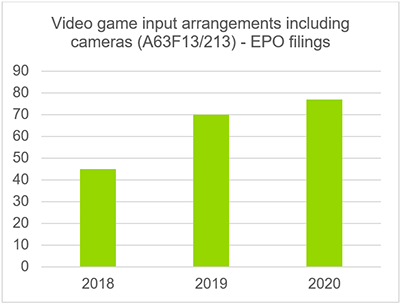
As an example, Disney are investing in technology which provides special interactivity based on a piece of merchandise or object held or worn by a player. The application describes using computer vision techniques to determine if, for example, a rider of a roller coaster is wearing a particular superhero’s “power gauntlet”. The rider can then interact with a virtual environment during the ride based on whichever superhero’s gauntlet they are wearing.
Does anyone else love the idea of deciding between Iron Man’s or Captain Marvel’s powers while lining up to blast virtual aliens on a roller coaster?
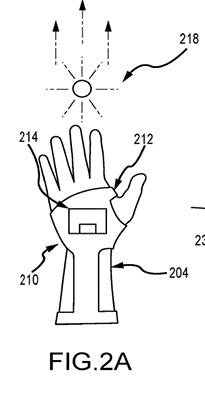
Universal Studios are also investing in AR and VR techniques to improve the customer experience. An application filed last year relates to hardware and software methods to detect when a headset of a ride has been damaged.
The technique involves using a camera located at the back of the headset, which takes the place of a player’s eye when the headset is not being worn, to spot image quality issues. By comparing test images captured by the camera with master images, smudges, stuck or dead pixels, and incorrect alignment with the real-world environment can be identified quickly and the headset can be flagged for repair or replacement.
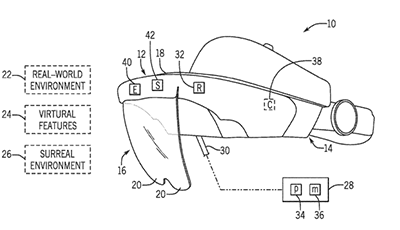
Theme park operators aren’t the only ones investing in AR and VR. The rumours surrounding Apple’s foray into the consumer AR/VR headset market have been fuelled in part by their patent filings in recent years, including this application which discloses inserting real-life objects from the user’s surroundings into a virtual environment when the user gets too close. The idea here is that, if you are getting engrossed in blowing up virtual planets and space-craft, you might appreciate a visual head’s up if you are about to run into your desk or lamp...
(Off-topic, but my favourite figures from Apple’s recent AR-related applications can be found in this application, which discloses using cameras to monitor a user’s face in order to modify the expression of an extremely friendly-looking fish.)
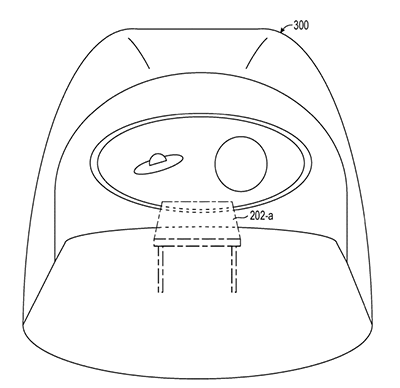
Upward trend #2: Managing an online community using player data -
A63F 13/79
This technology area relates to the general concept of collecting data about the player to build a gamer profile, which can then serve as a building block for services and applications that aim to create a social community of gamers, grow relationships among players, and tailor games to individual players.
Video games are the new social media: they are platforms which bring people together. MMO games, for example, allow players to communicate, build strategies, and form meaningful friendships. Online gaming has never been so popular, and video game companies are using the wealth of available gamer data to build, manage, and occasionally police the online community to improve the player experience.
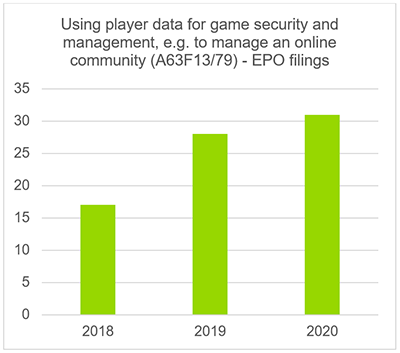
Sony Interactive Entertainment is investing in technology which is able to analyse your historic play behaviour, as well as that of your online peers, in order to infer when you might be available to participate in a video game activity. The application discloses using AI to make personalised inferences regarding free periods of time in which a user may be interested in participating in a suggested activity.
I love the idea of an AI-powered personal assistant that is able to suggest and schedule video game sessions for me and my friends. Of course, this will make it even harder to use my willpower to tear myself away from my console…
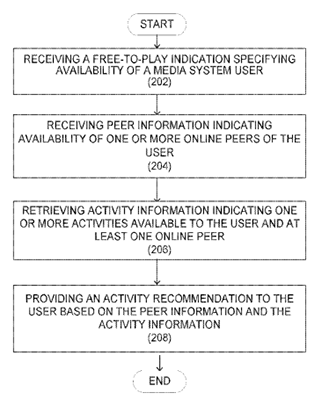
AT & T have filed an application aimed at detecting and counteracting suspicious activity in an application environment. The technique involves monitoring how a player responds to stimuli relative to the broader population of players, in order to build a user-specific play ‘signature’. That signature can then be used to identify instances of player fraud and collusion. In competitive environments, for example, the signature can be used to validate whether the user that is allegedly playing the game is actually the person playing the game.
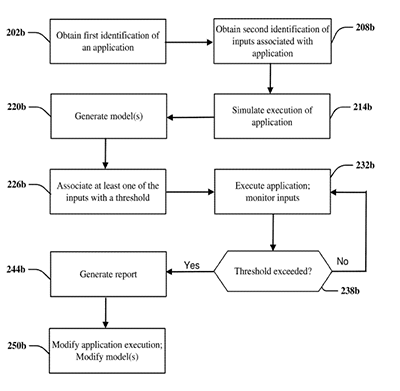
Many developers are interested in tackling ‘bad behaviour’ in the community, and this application from Sony Interactive Entertainment is a great example.
The application discloses identifying not only users who are actively exhibiting abusive or harassing behaviour, but also users who are unintentionally negatively impacting the experience of another gamer. There is a really interesting discussion on assessing various scenarios of a player damaging both an in-game monster and an in-game (presumably innocent?) tree.
The intention of game developers in this area is to enable each user to have a satisfying game play experience and keep the players engaged in the game.
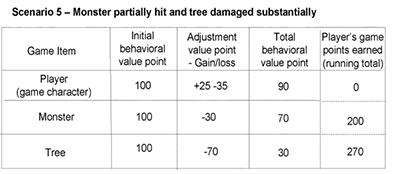
Upward trend #3: Watching games played by other players -
A63F13/86
Esports are booming. The International Olympic Committee has discussed their inclusion in future Olympics events, and in April this year announced a landmark move into virtual sports by announcing the first-ever Olympic “Virtual Series”.
The continued popularity of esports, along with video game streaming platforms such as Twitch, has led many companies to invest heavily in the technology which allows audiences to watch their favourite players.
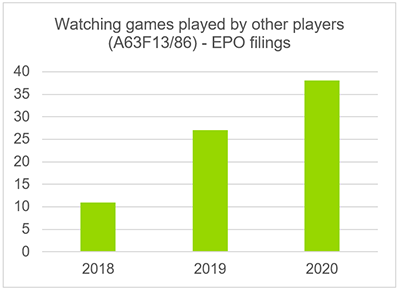
Several technical problems present themselves when streaming a video game to an audience around the globe. For example, recording the screen while playing the game will increase the power consumption of the terminal device. Uploading game videos may interfere with the uplink transmission of the game itself, and large amounts of data must be transmitted and synchronised.
Several applications have been filed directed to attempts to solve these issues in recent years, including this application from Huawei seeking to protect a cloud gaming live broadcast method. Audio is recorded at the user’s terminal, while the video is generated on the server side. The audio is then recombined with the video before being broadcast via a live broadcast platform. This way, data transmission is efficient and power consumption is minimised.
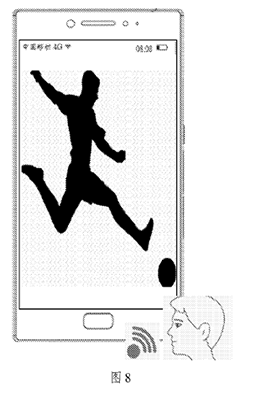
Activision has filed a wide-ranging application that describes a platform capable of giving spectators many options when viewing esports, allowing a spectator to swap between viewing: storylines automatically determined as being the most entertaining, a viewpoint associated with a particular player within the virtual environment, kill-cam replays, as well as a completely customised camera position and/or orientation within the virtual environment.
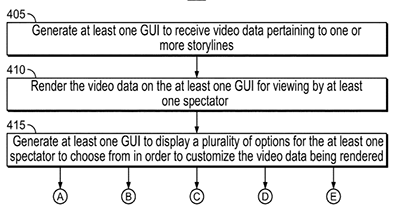
Loading the next level… what next for games?
For me, video games and related technologies have been a huge help in dealing with enforced isolation during the pandemic. I’ve used my VR headset to escape into virtual worlds from the safety of my living room, and to have ‘face-to-face’ meetings with colleagues and friends. Networking and keeping in touch with friends in 2020/21 has been accomplished through the mediums of Mario Kart, Among Us, and Worms W.M.D.
The future lies in technologies which better connect us, whether that be in a virtual environment, through fostering and protecting online communities of gamers, or allowing us to watch and interact with other gamers across the globe.
If the news and recent global events have been getting you down, you may need to hear an uplifting vision of the future. In which case, consider this. Combining the above three trends together, I expect that in the near-future we will all be able to put on our VR headsets (in accordance with the optimal time scheduled by our AI-assistants, of course) and be transported to a safe and well-managed virtual environment, entirely tailored to our own personal preferences and those of our peers, in order to watch the latest esports game with our friends. All from the comfort of our own homes.
Is anyone else suddenly a little more optimistic about the future?
For more information; to agree, disagree or engage in a good-natured argument about these trends; or to ask for advice on patenting software and video game-related technologies in Europe, please contact Tom Hamer.